November 30, 2023 – Volume 25, Issue 11
In This Issue
- Flanigan’s Net Positive: The Highs and Lows of Climate Change
- Big-Time PV in the United Arab Emirates
- First Sustainably-Fueled TransAtlantic Flight
- New York’s Premier Building Electrification
- 1,000 Year-Old Persian Windmills
- Renaming Natural Gas
- EV Equity
- International Shipping
- Electric Vehicle National Adoption Rates
- China’s High Speed Rail Network
- Taking Eco-Action: The Power of the Increment!
- Flanigan’s Eco-Logic Podcast Updates
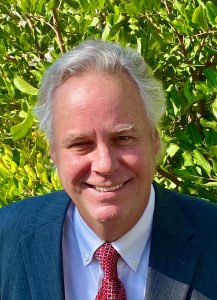
Flanigan’s Net Positive: The Highs and Lows of Climate Change
EcoNet News has been packed with good news on climate for many years. We focus on the positive steps while being painfully cognizant of reality. The world is heating up. Great efforts with renewables are falling short of overcoming rising temperatures. China is the world’s largest wind and solar power generator… yet it has 306 new coal-fired power plants under construction. The Saudi’s have an Oil Sustainability Program, for energy access in developing markets.
In the United States, we will likely extract an all-time high level of 12.9 million barrels of crude oil this year. Natural gas production will hit a record production level too. Thus the battle to save the planet from the ravages of climate change is only heating up. Moving quickly to protect our basic ecosystems and to scale has been discussed for decades. It’s critical now.

COP28: Some are sarcastically calling it “the oil kingdom’s climate summit…” the 28th IPCC Conference of Parties (COP). There was a leak that the UAE planned to strike oil and gas deals at the conference. The UAE has been criticized for placing Sultan Al Jaber, the CEO of the state oil company, the Abu Dhabi National Oil Company, as president of COP28 in charge of the conference which began on November 30th. Is the UAE hosting a COP a thinly veiled public relations ploy? His company is the 12th largest oil company in the world. It is among the 100 major companies responsible for the vast majority of greenhouse gas emissions.
The United Arab Emirates government has an “all-of-the-above” energy policy… inclusive of oil and gas. While the UAE has stated that it will be carbon neutral by 2050, it also has stated that this will be done incongruously with a 50% renewable contribution. Hunter Lovins states that the Saudis are making a billion dollars a day for every day that climate action is delayed. Certainly the UAE is also reaping the benefits of oil revenues at the expense of the climate.
But good news: Fully 97,000 experts and advocates and passionate souls from around the world have registered for the COP. There are delegates from over 200 countries. One of Sultan Ahmed Al Jaber’s first actions was unifying the attendees, establishing a fund to help vulnerable countries with climate change. The UAE seeded the so-called Loss and Damage Fund with $100 million that grew that day to $260 million. The UAE has also just commissioned the world’s largest, single-site solar plant. It’s featured in this issue.
Of course, these positive steps are tempered by a new, scary reality: For a day, November 17th, the average worldwide temperature was the hottest day on record. On that day, the global average surface temperature was more than 2°C higher than pre-industrial levels for the first time since records began. Fortunately, it was a moment in time, versus long-term average temps. Fortunately we are not slated to reach that long-term average temperature level until the 2040s or 2050s.
In the U.S., we are making progress, but not fast enough. Pre-covid efforts have resulted in a steady decline in greenhouse gas emissions. From 2012 through 2021, U.S. emissions dropped by an average of 1% per year. According to the U.S. Energy Information Administration, the United States is expected to cut emissions by 3% in 2023 reversing two years of flat or increasing emissions. This is positive, especially in light of the economy’s 2.5% growth rate. But the cut is half of the 6% annual reduction needed to be on track to slash emissions by 50 – 52% from 2005 baseline levels by 2030 in line with the Paris Climate Accord. The reductions are good, but not at the scale required. Inflation Reduction Act provisions will help, but don’t expect the legislation to move mountains in its first year, warned a Rhodium Group consultant that tracks emissions.
Hunter Lovins underscores the sobering reality that 2023 will likely be the hottest year ever in human history. There have been a record 25 billion-dollar-plus weather disasters this year. These include flooding, droughts, famines, fires, and more. Lovins reports that climate change is already costing the world about $16 million per hour. It’s time to bend this equation… to invest heavily now. Stanford professor Mark Jacobson suggests the worldwide transition to clean energy will cost $62 trillion. But that’s cheaper than the alternative and has a payback: Advanced technologies bear upfront costs but low operating costs as they harness free resources… the wind, sun, falling water, waves, tides, and the Earth’s heat.
The Paris Climate Accord established a goal to limit the increase in the global average temperature to “well below 2°C above pre-industrial levels” and pursue efforts to limit the temperature increase to 1.5°C above pre-industrial levels. The Dubai delegates must now address this in full. We salute the recent U.S./China collaboration on climate led by John Kerry, the president’s special envoy on climate. Our countries have a mutual interest in stemming the ravages of climate havoc. Some think this partnership, and the stark state of the global climate, will drive significant action in Dubai. Let’s hope so.
Quote of the Month
“Kindness is the connection that links us all together and strengthens the bonds within our communities, neighborhoods, and families.”
Big-Time PV in the United Arab Emirates
In advance of COP28 in Dubai, the United Arab Emirates developed the largest, single-site photovoltaic plant in the world. In full sunshine, the 2 GW installation has the equivalent capacity of two nuclear reactors. The plant was inaugurated on November 16th, two weeks before the climate summit.
The massive Al Dhafra solar farm is located 22 miles from Abu Dhabi and is 7.72 square miles in size. It is made up of four million, bifacial solar panels and will eliminate 2.4 million tons of CO2 emissions each year. There were 4,500 workers on site during peak construction, installing 10 MW of solar per day. The project was jointly developed by Masdar, Taqa, the French-owned EDF Renewables, and JinkoPower, a Chinese solar developer. Power will be sold through a power purchase agreement (PPA) to Emirates Water and Electric Company.
First Sustainably-Fueled TransAtlantic Flight
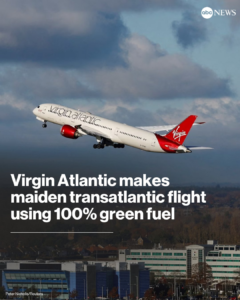
Image Courtesy of World News Tonight Twitter Account
On November 27th, Virgin Atlantic made history by completing the first transatlantic flight of a commercial airliner using 100% sustainable aviation fuel (SAF). The London to New York flight took eight-hours covering 3,500 miles. The flight represents a major milestone on the path to decarbonizing aviation.
Global air travel is 2% of global greenhouse gas emissions, and its impact is expected to soar as more and more travel is done by planes. SAF comes from many sources such as biomass in the form of cornstalks and forest residues, hydrogen and captured CO2. According to Canary Media, nearly all the world’s existing supply of SAF comes from hydroprocessed esters and fatty acids (HEFA fuels). These are derived from pork fat, beef tallow, and yellow grease collected from restaurants and industrial kitchens. Virgin Atlantic’s plane was fueled with 60 metric tons of SAF, a mix of HEFA fuel and 12% synthetic aromatic kerosene derived from plant-based sugars.
Today, SAF accounts for only 0.1% of aviation fuels. There is very little supply. And engines may need to be retooled to run on 100% SAF. Current regulations allow for a maximum of 50% SAF on commercial, revenue flights. The Virgin flight required special approval and was not allowed to carry paying passengers. To spur the development of SAF, the United States has tax credits for airlines that buy SAF. The European Union requires airlines to use them. The EU has a target for 70% SAF by 2050. British regulators plan to require 10% SAF by 2030. Virgin Atlantic won a million pound prize from the British government for its transatlantic feat.
New York’s Premier Building Electrification

Image Courtesy of Rendering © DBOX for Foster + Partners
JP Morgan Chase’s brand new, and stunning headquarters, in New York City is taking shape fast, the 1,388 foot skyscraper topping out in November. To build the tower, JP Morgan Chase had to buy air rights from the nearby church, and from MSD Capital, the owner of the air rights above Grand Central Terminal.
The new building will house 14,000 employees and will include a penthouse conference center. It’s a LEED Platinum facility designed for health and wellness. Joe Allen, from Harvard’s TH Chan School of Public Health, is proud to have been part of the team that shaped this building. The 2.5 million square foot facility is setting new standards for health and sustainability.
The building is New York City’s largest all-electric tower, ahead of New York City’s ban on the use of natural gas in new construction in 2027 for buildings higher than seven stories. Located at 270 Park Avenue, the new, 60-story skyscraper is being built on site of JP Morgan Chase’s former headquarters, the Union Carbide Building. Chairman and CEO Jamie Dimon expects the new headquarters to be well suited to his staff with a super-healthy building, a focus on wellness, a fitness center, yoga and meditation spaces, a food hall, and lots of plants. Its $3 billion price tag pales in comparison to the company’s $129 billion gross profit in 2022.
According to Curbed, the building will be New York City’s largest all-electric building. Its heating and cooling accomplished with heat pump systems, powered by electricity generated by hydroelectric sources. It features triple-pane, super-energy-efficient glass. Its advanced water storage and reuse systems will reduce water usage by more than 40%. Designers used healthier building materials, and doubled the amount of outside, fresh air, which then meets advanced air filtration systems. Air quality will be monitored in real time including IAQ sampling. The ground level provides two and a half times as much publicly accessible, outdoor ground-level space as the old building.
1,000 Year-Old Persian Windmills

For those that think that harvesting the wind is a new idea, think not. Windmills have been used for centuries to pump water and grind grain. The Persians of Iran have a history of funneling the wind. They generate torque using drag, not lift. One town in Iran – Nashtifan – has been using wind structures that are 1,000 years old.
In Nashtifan, the Earthen windmills are embedded in a massive 65-foot tall wall that shelters the town. The wall funnels wind through vertical axis mills. Conventional Dutch and U.S. horizontal-axis machines need gears to transfer the horizontally generated power to the vertical axis mills. Nashtifan is in the arid and windswept plains of northeastern Iran, 20 miles from the Afghanistan border. The wall protects residents from the gale force winds. Made of clay straw, and wood, many of the two dozen mills there are still in operation.
Renaming Natural Gas

Natural gas sounds pretty benign. The term reminds some of us of a national park! Some say that the first step to phase out natural gas is to change its name. Research has shown that terminology affects perceptions. Cities in Canada and the United States are adopting the term, the term “fossil gas” is catching on.
Natural gas has been called fossil gas, methane gas, or simply gas. It is made up of 70 – 90% methane, one of the most dangerous and potent greenhouse gasses. Yet the American public looks favorably on natural gas. The term does not portray the origins of the methane gas… nor its impact.
Leading the charge to change its name in official documents is a former chemical engineer in the coal industry. British Columbia resident Eddie Dearden has been writing letters and showing up at council meetings, urging municipalities to change the term natural gas to “fossil gas” in official documents. While he’s gotten some pushback, some municipalities are accepting the new term, like Metro Vancouver. In New York, the term is catching on for climate action planning, guiding climate-friendly decisions. Now, Dearden has taken his campaign to another level: In a recent letter to B.C.’s Environment and Climate Change Minister, he included a draft of a potential bill called the “Fossil Gas Clarification Act, 2023.”
EV Equity

A few weeks ago I had the honor of facilitating a strategic planning session at the Board meeting of Plug in America (PIA). PIA is the trade association of EV drivers, founded in 2001. Its mission is to accelerate EV adoption. Has it been fulfilled? Is it in need of an update? While there is still plenty of headroom in the adoption of EVs, a new and critical focus is on EV Equity. How can all drivers -regardless of how much money they have and where they live – experience the benefits of EVs? There was much discussion of finding ways to promote equity through policies and incentives… and a big focus on filling in the EV “charging deserts,” those areas without adequate charging.
The City of Los Angeles has been a leader in analyzing its path to carbon neutrality. It hired the National Renewable Energy Laboratory (NREL) and University of California at Los Angeles to study its path forward and to present means to cut its carbon footprint to zero. The study concluded that the City would need to invest $87 billion to achieve its net zero goal. A big part of the equation is cars. Making EVs an option for all is critical to the City’s success.

Image Courtesy of LADWP
Los Angeles is promoting equitable EV adoption. It announced in November that it would strategically deploy electric vehicle chargers in overlooked areas, and that it would offer bigger rebates for the purchase of battery-powered cars in response to a new report that concluded that low-income people were being left behind in the transition to clean energy. City officials said they would offer qualified residents up to $4,000 to buy used electric vehicles, up from $2,500. The City is also resolute in its commitment to build a network of fast chargers.
International Shipping

Image Courtesy of EDF
Environmental Defense Fund (EDF) reports that international shipping is responsible for a huge amount of greenhouse gas emissions. If maritime shipping were a country, EDF claims that it would be the sixth largest country in the world in terms of emissions.
Big ships run on bunker fuel, considered “the dregs” of the oil refining process. There are almost 100,000 such ships, moving 11 billion tons of goods across the world’s oceans each year. Shipping is inherently efficient… more so that trucking, train, and certainly plane travel.
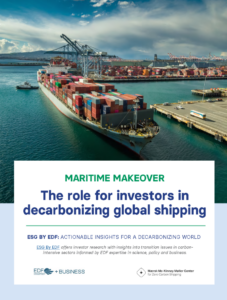
Image Courtesy of EDF
The United Nations’ International Maritime Organization has been leading the charge to clean up shipping. The IMO is working with EDF which now has earned consultant status. The IMO forged an agreement in July which called for peak emissions in shipping “as soon as possible,” and for the shipping sector to be net zero by 2050. The interim target is a 20% reduction by 2030 and at least a 70% reduction by 2040. Ten major shipping lines – including Maersk, Nippon Yusen Kaisha, and Hapag-LLoyd – have made commitments to these targets.
In addition to contributing to the climate crisis through its gross emissions, shipping is facing the ravages of climate change: More intense storms are damaging ships. In some cases, high seas cause rolls that are pitching huge containers overboard.
EDF’s Director of Global Shipping is based in London and has a vision for shipping shifting from one of the most polluting sectors, to one of the cleanest. How? There are a number of means to reduce emissions: Aligning investors with green shippers. Better coordination of shipping can result in less time idling outside of ports where ships wait for times to unload and load. When at port, ships can use power from shore – known as cold ironing – versus idling their polluting engines. The EU Fit for 55 climate package will require certain ships to use shore power by 2030, as is the rule in California. Federal legislation has funded solutions including $20 billion to reduce climate and air pollution from U.S. ports.
Major customers of international shipping – including Amazon, Unilever, Target, and IKEA and German retailer Tchibo – have committed to only using cargo ships that have zero emissions by 2040. Newly designed propellers pack a punch. The industry is establishing green shipping corridors, specific trade routes that will make it easy for ships to access lower carbon fuels and onshore power. The industry is testing new types of fuels… including ammonia, hydrogen and methanol. And even wind is now being used to augment conventional fuels, taking shipping back to its oldest form of propulsion.
Electric Vehicle National Adoption Rates
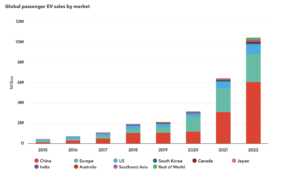
Image Courtesy of BloombergNEF EV Outlook
Associated Press reports that electric vehicle sales are anticipated to constitute 9% of U.S. passenger vehicles sales in 2023, up from 7.3% in 2022. It will be the first time that more than one million EVs are sold in a year in the United States. Atlas Public Policy states that there will be 1.3 – 1.4 million EV sales this year.
The report notes, however, that the U.S. is lagging behind other countries. In Norway, EV sales are 90% of the market; in China the value is 33%; in Germany it’s 35%. These values are based on the first six months of the year, and are from Bloomberg NEF. The values reflect both battery electric vehicles and plug in electric vehicles.
How are these countries dusting America in EV sales? How do they do it? They do it with tax credits, subsidies, and affordable EV options. While the United States is not leading the charge, progress is still impressive as the market matures and the forces of competition fire up. EV prices are coming down. Tesla has had multiple price reductions this year, forcing other EV makers to do the same. Falling battery costs has been an enabling factor.
Still there are hurdles in widespread EV adoption. Early buyers have generally been wealthy homeowners who can charge their EVs at home with ease, and very affordably. For others, the lack of charging infrastructure is a major barrier, as are concerns about EV reliability. Furthermore, EVs still bear a cost premium over ICE vehicles. According to Bloomberg NEF, EVs on average cost $3,826 more than the average new ICE car… going for $51,762 versus $47,936 for their fossil-burning ancestors.
China’s High Speed Rail Network

The People’s Republic of China has the longest and most extensively used high speed rail network in the world, with 26,000 miles of track at the end of 2022. In fact, China accounts for two-thirds of the world’s high speed railway networks, its trains running at 120 – 220 miles per hour. The trains and tracks are almost exclusively owned by the China Railway Corporation and are branded as China Railway High Speed (CRH).

High-speed rail has been developed rapidly in China since the mid-2000s. Currently, the network extends to all provincial-level administrative divisions and Hong Kong with the exception of Macau. Building continues and the high speed network is set to reach 43,000 miles by 2035.
Taking Eco-Action: The Power of the Increment!

Americans buy 30 million Christmas trees every holiday season. Imagine if we all bought live potted trees and then planted them the next spring.
Flanigan’s Ego-Logic Podcast Updates
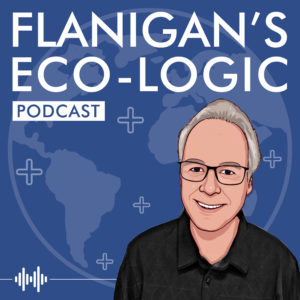
Use the links below to check out our recent podcasts. And you can always go to Spotify and type in “Ted Flanigan” to find our library of podcasts.
Recently Released:

EcoNet News, Volume 25, Issue #4, celebrates Rocky Mountain Insititue’s (RMI) impact! Ted shares his experience attending the RMI alumni event and reunion. The issue also highlights single-use battery disposal, renewables topping coal, offshore wind and fish farming, free public transportation in Luxembourg, parking lot solar, Six Flags plan to install to install one of the largest solar carports in the country.
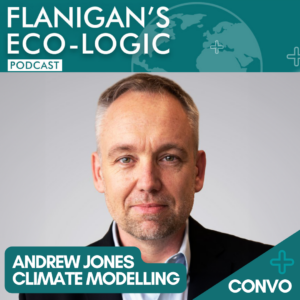
In this episode of Flanigan’s Eco-Logic, Ted speaks with Andrew Jones, Executive Director and Co-Founder of Climate Interactive, and a Research Affiliate at MIT Sloan. Climate Interactive is rooted in the fields of system dynamics modeling and systems thinking.
He and his team developed C-ROADS and En-ROADS, two user-friendly climate simulations in use by analysts around the world. These tools help people see connections and drive effective and equitable climate action. Andrew and Ted discuss how climate modeling is an important step towards mitigating carbon emissions and making the right policy and personal choices to drive down emissions.
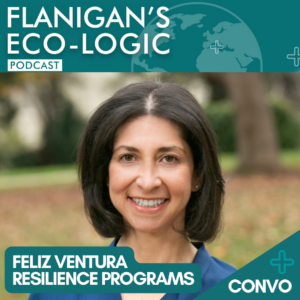
In this episode of Flanigan’s Eco-Logic, Ted speaks with Feliz Ventura, Resilience Programs Manager for Ava Community Energy, an innovative Community Choice Aggregator in California providing more renewable energy at competitive rates to its customers.
Feliz brings nearly two decades of experience in making the case for investments that ensure communities thrive in the context of the rapid technological and climatic changes of the 21st century. Prior to Ava, Feliz worked to integrate climate resilience into infrastructure, urban and real estate development at two global planning, design, and engineering firms, led the State of Washington’s cleantech economic and market development program, and worked with global startups to measure and improve their ESG performance at the World Resources Institute in Washington, D.C.
At Ava, Feliz leads the Resilience Programs, focused on developing and implementing energy resilience solutions for municipal, residential, and medical customers that result in wide-ranging benefits across Ava’s service area.

In this episode of Flanigan’s Eco-Logic, father-daughter duo, Ted and Sierra Flanigan host the clean energy crash course focusing on campus sustainability, specifically spotlighting EcoMotion’s work with the Chula Vista Elementary School District.
They start at a high level, being that working on campuses and sustainability is a shared passion in their professional careers – Sierra more on the strategic side, and Ted more on the operations side.
The EcoMotion team performed a feasibility analysis for all 49 campuses, revealing the opportunity to save $60-77 million over 25 years. Ted then presented this to the school board, and they authorized EcoMotion to proceed with releasing an RFP for full-scale solar. With the passing of the bond, EcoMotion projected $88 million in savings, which has now been recalculated to over $100 million in savings with the escalation of utility rates. With the contractor, Engie, selected, EcoMotion facilitated project oversight and quality control, maintaining owner’s rep throughout construction, which took a little over 2 years. The 49 sites were in aggregate of 8.1 MW total (175-200 kW per school site), with approximately 18,000 panels, offsetting approximately 80 percent of annual consumption.
Ted shares that the Chula Vista ESD experience can be emulated at other school districts and that there are major opportunities for major energy, cash, and environmental savings. He concludes by sharing that it is also a lesson in smart energy management for students, staff, and teachers alike. It is something to be proud of, and a solar lesson to take home that will have a generational impact.
